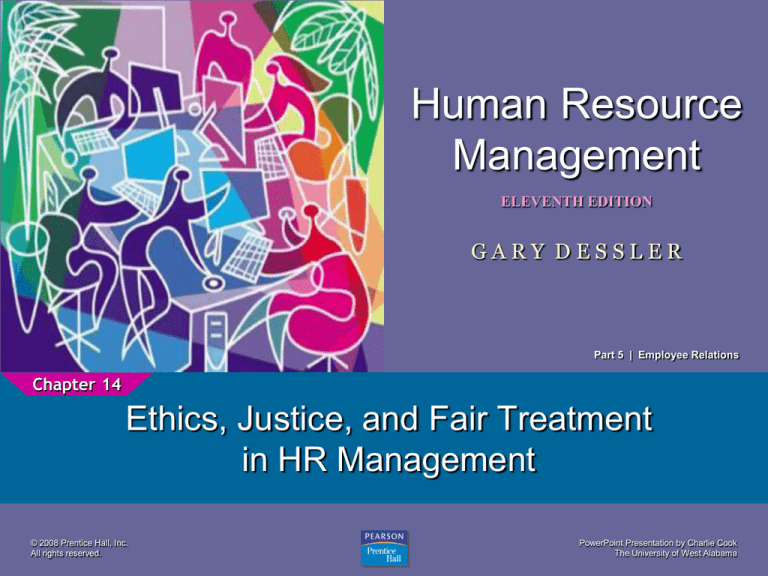
Human Resource
Management
ELEVENTH EDITION
1
GARY DESSLER
Part 5 | Employee Relations
Chapter 14
Ethics, Justice, and Fair Treatment
in HR Management
© 2008 Prentice Hall, Inc.
All rights reserved.
PowerPoint Presentation by Charlie Cook
The University of West Alabama
After studying this chapter, you should be able to:
1. Explain what is meant by ethical behavior at work.
2. Discuss important factors that shape ethical behavior
at work.
3. Describe at least four specific ways in which HR
management can influence ethical behavior at work.
4. Employ fair disciplinary practices.
5. List at least four important factors in managing
dismissals effectively.
© 2008 Prentice Hall, Inc. All rights reserved.
14–2
Ethics and Fair Treatment at Work
• The Meaning of Ethics
The principles of conduct governing
an individual or a group.
The standards you use to decide
what your conduct should be.
Ethical behavior depends on a
person’s frame of reference.
• Ethical Decisions
Normative judgments
Morality
© 2008 Prentice Hall, Inc. All rights reserved.
14–3
What Is Organizational Culture?
• Organizational culture
The characteristic values, traditions, and behaviors a
company’s employees share.
• How is culture is revealed?
Ceremonial events
Written rules and spoken commands
Office layout
Organizational structure
Cultural symbols and behaviors
Figureheads
© 2008 Prentice Hall, Inc. All rights reserved.
14–4
HRM-Related Ethics Activities
• Selection
Enhancing the perception of fairness in the
processes of recruitment and hiring of people.
Formal procedures
Interpersonal treatment
Providing explanations
Selection tools
Two-way communication
• Training
How to recognize ethical dilemmas.
How to use ethical frameworks to resolve problems.
How to use HR functions in ethical ways.
© 2008 Prentice Hall, Inc. All rights reserved.
14–5
HRM-Related Ethics Activities (cont’d)
• Performance Appraisal
Appraisals that make it clear that the company
adheres to high ethical standards by measuring and
rewarding employees who follow those standards.
• Reward and Disciplinary Systems
The organization swiftly and harshly punishes
unethical conduct.
© 2008 Prentice Hall, Inc. All rights reserved.
14–6
Discipline Without Punishment
(Nonpunitive Discipline)
1. Issue an oral reminder.
2. Should another incident arise within six weeks, issue a
formal written reminder, a copy of which is placed in
the employee’s personnel file.
3. Give a paid, one-day “decision-making leave.”
4. If no further incidents occur in the next year, then
purge the one-day paid suspension from the person’s
file. If the behavior is repeated, the next step is
dismissal.
© 2008 Prentice Hall, Inc. All rights reserved.
14–7
Managing Dismissals
• Dismissal
Involuntary termination of an employee’s
employment with the firm.
• Terminate-at-Will Rule
Without a contract, the employee can resign for any
reason, at will, and the employer can similarly
dismiss the employee for any reason (or no reason),
at will.
© 2008 Prentice Hall, Inc. All rights reserved.
14–8
Avoiding Wrongful Discharge Suits
• Bases for Wrongful Discharge Suits
Discharge does not comply with the law.
Discharge does not comply with the contractual
arrangement stated or implied by the firm via its
employment application forms, employee manuals,
or other promises.
• Avoiding Wrongful Discharge Suits
Set up employment policies and dispute resolution
procedures that make employees feel treated fairly.
Do the preparatory work that helps to avoid such
suits.
© 2008 Prentice Hall, Inc. All rights reserved.
14–9
Termination Assistance
• Outplacement Counseling
A systematic process by which a terminated
employee is trained and counseled in the techniques
of conducting a self-appraisal and securing a new
job appropriate to his or her needs and talents.
Does
not imply that the employer takes
responsibility for placing the person in a new job.
© 2008 Prentice Hall, Inc. All rights reserved.
14–10
Interviewing Departing Employees
• Exit Interview
Its aim is to elicit information about the job or related
matters that might give the employer a better insight
into what is right—or wrong—about the company.
The
assumption is that because the employee is
leaving, he or she will be candid.
The
quality of information gained from exit
interviews is questionable.
© 2008 Prentice Hall, Inc. All rights reserved.
14–11
KEY TERMS
ethics
organizational culture
dismissal
© 2008 Prentice Hall, Inc. All rights reserved.
wrongful discharge
exit interviews
14–12



